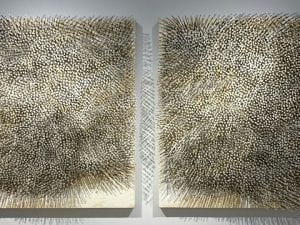Featuring work from Hepworth’s later years, A Greater Freedom celebrates the raw beauty and experimental nature of the pieces. Specifically, the show focuses on the new materials used by the prolific sculptor in the 1960s. The exhibition seeks to represent Hepworth’s “conviction about truth in material” and the fact that she had found ‘‘a greater freedom for myself’’ during this period.
The striking interplay of light in the space exaggerates shadows cast by the marble forms. It was interesting to learn that marble rarely changes colour under other people’s hands, and therefore is a useful material to work with on large projects. The stoic marble sculptures are reminiscent of the artist’s own tenacity, having described locking herself up for a day in order to work to the best of her ability. Much of the artwork included in the exhibition represents the relationship between forms both human and natural, and how they interact to create something of beauty. Two Forms with White (Greek) (1963) is imbued with a great sadness – the heart and womb of these pieces has been scooped out, leaving a hollow space. Here Hepworth truly experiments with both the inner and outer layers of the human form, creating work that is touching and provocative.
Hepworth was fascinated by the manner in which shape contributed to the sense of movement in her sculptures. Often described as puritanical and geometric, observing Hepworth’s experimentation with shapes and angles redefines her earlier practice. A technique of layering adds depth and structure, especially prevalent in Maquette Theme and Variations (1970), in which the artist employs this layering method on silver and walnut wood. New technology is also hinted at throughout the exhibition, with an emphasis on Hepworth’s innovative and at times transgressive technique, exemplified by the polished bronze of Three Hemispheres (1967).
Although Hepworth’s use of materials and techniques was transient, the central themes in her work render it distinctive and instantly recognisable. Through the concept of rebirth, Hepworth reminds us that life is filled with circles; an orb of constant repetitions, cyclical moon patterns, wombs and shells. Whilst quite a haunting subject, there is also something reassuring about the concept that everything is in a constant state of movement. Although we may all be seemingly trapped in these circles, we are steadily rotating together.
A Greater Freedom: Hepworth 1965 – 1975, The Hepworth Wakefield, Gallery Walk, Wakefield, West Yorkshire WF1 5AW, until April 2016.
Millie Douce
For more information visit www.hepworthwakefield.org.
Follow us on Twitter @AestheticaMag for the latest news in contemporary art and culture.
Credits
1. Barbara Hepworth, Two Forms with White (Greek), 1963.. Courtesy of Jonty Wilde and Hepworth Wakefield.





